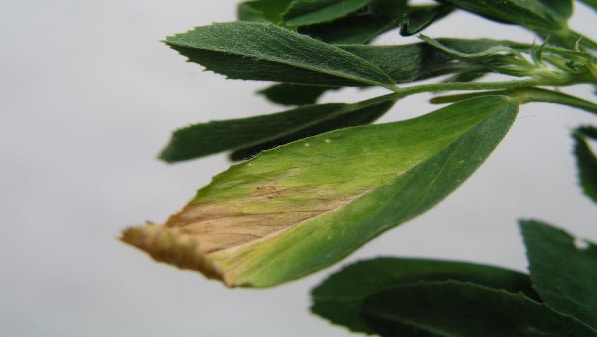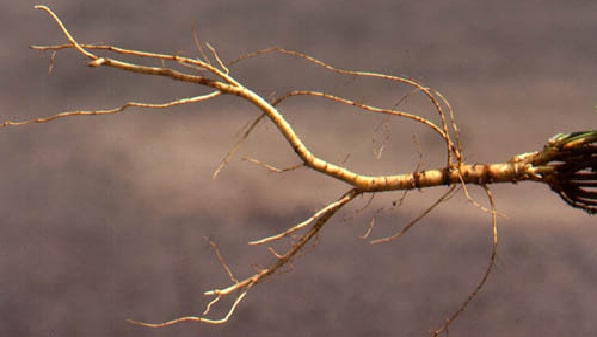
Aphanomyces 1 & 2
Aphanomyces is a common disease of wet soils. This disease is an oomycete that causes plants to become yellow and stunted. Infected seedlings will have yellow cotyledons and emerging leaflets that will begin to turn yellow. Seedlings will begin to then die back and become stunted. Established plants that are infected will have dead, decaying roots that are gray and water-soaked in appearance and then turning a light to dark brown. This will lead plants to have much smaller root masses and to exhibit symptoms that commonly resemble a nitrogen deficiency. It is not uncommon to see nodules decaying as well or even absent in some cases. Struggling to regrow after cutting may also be an indicator of aphanomyces. Aphanomyces has several different strains that affect plants, race 1 being the most common and the most common for plants to have resistance to.
Anthracnose
Anthracnose is a fungus that affects alfalfa plants and can cause up to 25% yield loss. Warm, moist conditions favor the onset of this disease. Plants that are susceptible to this typically show large, sunken, diamond shaped lesion on the lower portions of the stems. These lesions will have white centers and brown edges. Lesions can grow and join together and kill the stems. Young dead shoots that have been killed by the disease exhibit a “shepherds hook” appearance. Affected plants will be scattered around the field and should not be confused with frost damage. Crowns that become infected with this disease will get a blue/black color and will not produce stems as well as a healthy plant would. Eventually the infected plants will begin to die off.


Fusarium Wilt
Fusarium wilt is a fungus that may commonly be confused with bacterial wilt. Unlike bacterial wilt, this disease does not cause the plants to become stunted. Fusarium wilt causes shoots and plants to wilt during the day but they will seem to recover overnight. Leaves and stems of infected plants will turn yellow and then become bleached or have a reddish tinge. This however, will be seen on only one side of the plant. The plant will die off as the disease progresses and encompasses the root of the plant. This causes a gradual thinning of the alfalfa stand. Good fertility and control of alfalfa pests such as pea aphids and potato leafhoppers will help in controlling the impact of this disease.
Verticillium
Verticillium wilt is a fungus that can severely affect plant stands and cause large economic loss. Some of the first symptoms to show up include yellowing V shaped patterns at the tips of the upper leaflets. As the disease progresses, the leaflets will begin to wilt and turn brown and die while the stem of the plant remains green. The disease will slowly progress down to the crown of the plant where it will then cause the plant to slowly die over the course of several months. The vascular tissues in the root may show internal browning as well. It is important to plant resistant varieties or rotate with non host crops to control this disease.


Phytophthora Root Rot
Phytophthora root rot is a fungus that affects both seedlings and established plants in cool, water saturated soils. This disease occurs as plants emerge in wet soils. Affected roots will be a yellow-brown color; lesions may be seen just above the surface. In severely affected plants, they turn black as they begin to rot off and die. Leaves of infected plants will show a chlorotic color or reddish leaves that will begin to drop off the plant. This is especially seen in the lower leaves. It is difficult to detect this disease until the soils dry up and the plants begin to wilt due to their infected root masses. Crop rotation will provide little relief for this disease. Good management practices such as high fertility and insect control will keep the plants less stressed and susceptible to disease.
Bacterial Wilt
Bacterial wilt is commonly seen in second and third year stands. This disease is usually seen scattered throughout the field, causing plants to show chlorotic symptoms. If a plant is severely infected, it may become stunted and have spindly stems and may begin to die off. It is easiest to detect this disease after a cutting as it is trying to regrow. Older stands that are 3-5 years in will be much more effected and have a much higher incidence of stand loss.


Sclerotinia Crown and Root Disease
Sclerotinia crown and stem rot disease usually causes most damage in fall-seeded stands, but single or groups of plants in stands of any age can be killed. Sclerotinia usually occurs when the fall is cool with wet weather in the late fall and snow cover in the winter. The disease can easily go unnoticed if only scattered plants or small patches in fields are killed and may be mistaken for winterkill. Watch for the disease in April to May the following year. Plants appear dead or wilting. Look for white moldy growth and sclerotinea on the stems. They will appear as small black, round to elongated fungi. The crown of the plant can also be infected and have the white moldy growth and if you open the crown it will have a yellow to brown color. Wilted or dead stems can also be infected. Splitting the stem with a knife, they will be discolored. Management of Sclerotinia crown and stem rot of alfalfa is based on site selection, planting date, crop rotation, and tolerant varieties. If possible, new fields of alfalfa should be established where there is no history of the disease. Spring planting allows the plants to develop resistance prior to the time that most infection occurs in the late fall.